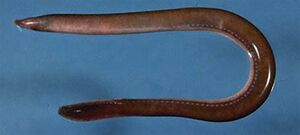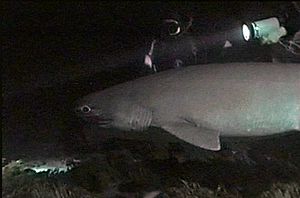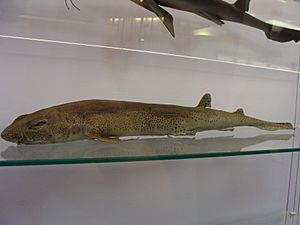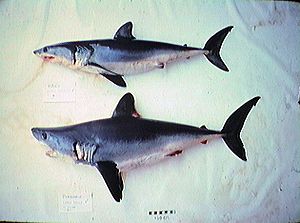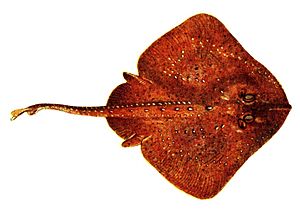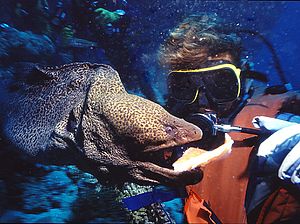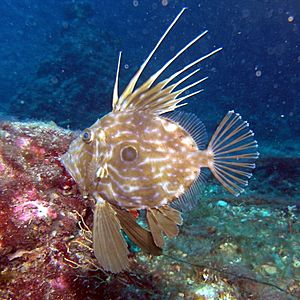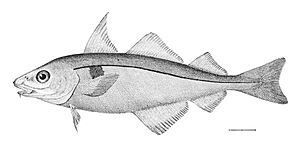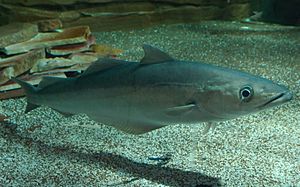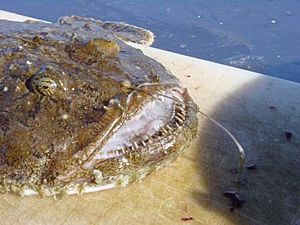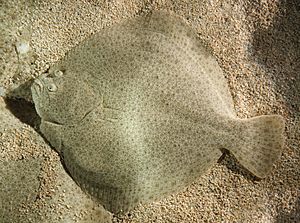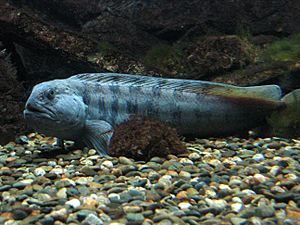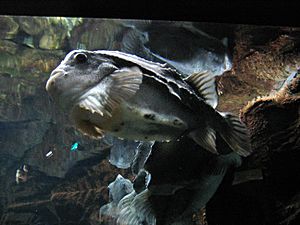List of fish of Ireland facts for kids
This article lists the different kinds of fish you can find in the waters around Ireland. It includes both fish that live in the sea and those that live in freshwater. You'll also learn about their conservation status, which tells us how much they are at risk of disappearing.
Here's what some of the conservation terms mean:
| Extinct | This means the last fish of that kind has died. | |
| Extinct in the wild | These fish only live in zoos or special places, not in nature anymore. | |
| Critically endangered | These fish are in very, very high danger of becoming extinct in the wild. | |
| Endangered | These fish are in very high danger of becoming extinct in the wild. | |
| Vulnerable | These fish are facing a high risk of becoming extinct in the wild. | |
| Near threatened | These fish are not in immediate danger, but they might be in the future. | |
| Least concern | There are no big worries about these fish right now. | |
| Data deficient | We don't have enough information to know how much risk these fish are in. |
Contents
- Amazing Fish of Ireland's Waters
- Hagfish: Ancient Ocean Dwellers
- Lampreys: Unique Jawless Fish
- Sharks and Rays: Cartilage Skeletons
- Bony Fish: The Most Common Fish
- Sturgeons: Ancient Giants
- Herring and Anchovies: Schooling Fish
- Eels: Long and Slithery
- Salmon and Trout: Iconic Irish Fish
- Lanternfishes: Deep-Sea Lights
- John Dory: A Unique Look
- Cod and Relatives: Important Food Fish
- Anglerfishes: Masters of Disguise
- Flatfishes: Living on the Seabed
- Tuna and Mackerel: Fast Ocean Swimmers
- Swordfish: The Ocean's Swordsman
- Weeverfishes: Hidden Dangers
- Wolffishes: Strong Jaws
- Lumpsuckers and Snailfishes: Sticky Friends
- Sunfish: Giant Ocean Drifters
- Freshwater Fish of Ireland
- Images for kids
Amazing Fish of Ireland's Waters
Hagfish: Ancient Ocean Dwellers
Hagfish are very old types of fish. They don't have jaws and their bodies are soft. They are often called "slime eels" because they can produce a lot of slime when they feel threatened.
- Atlantic hagfish, Myxine glutinosa
Lampreys: Unique Jawless Fish
Lampreys are another ancient group of fish. They also don't have jaws. Instead, they have a round, sucking mouth with sharp teeth. Some lampreys live in the sea and then swim up rivers to lay their eggs.
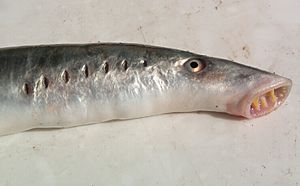
- European river lamprey, Lampetra fluviatilis
- Sea lamprey, Petromyzon marinus
Sharks and Rays: Cartilage Skeletons
Sharks and rays are special because their skeletons are made of cartilage, not bone. Cartilage is the same flexible material found in your nose and ears.
Sharks: Predators of the Deep
Sharks are powerful hunters. They come in many shapes and sizes. Some live close to the shore, while others prefer the deep ocean.
Angelsharks: Flat and Hidden
Angel sharks are flat-bodied sharks that look a bit like rays. They hide on the seabed, waiting to ambush their prey.
- Angel shark, Squatina squatina
Dogfishes: Small but Mighty
Dogfishes are generally smaller sharks. Many of them live in deep waters.
- Leafscale gulper shark, Centrophorus squamosus
- Velvet belly lantern shark, Etmopterus spinax
- Greenland shark, Somniosus microcephalus
- Spiny dogfish, Squalus acanthias
Frilled and Cow Sharks: Living Fossils
These sharks are very ancient. The frilled shark looks like an eel with many gills. The bluntnose sixgill shark is a large, deep-water shark.
- Frilled Shark, Chlamydoselachus anguineus
- Bluntnose sixgill shark, Hexanchus griseus
Ground Sharks: Common Ocean Hunters
This group includes many well-known sharks. They are often found near the seabed or in open waters.
- Blue shark, Prionace glauca
- Lesser spotted dogfish, Scyliorhinus canicula
- Smooth hammerhead, Sphyrna zygaena
- Tope, Galeorhinus galeus
Mackerel Sharks: Fast Swimmers
Mackerel sharks are known for being fast and powerful swimmers. They include some of the largest sharks.
- Common thresher, Alopias vulpinus
- Basking shark, Cetorhinus maximus (The second largest fish in the world!)
- Porbeagle, Lamna nasus
- Shortfin mako shark, Isurus oxyrinchus
Rays and Skates: Flat-Bodied Wonders
Rays and skates are flat fish that spend most of their time on the seabed. They use their large, wing-like fins to glide through the water.
Electric Rays: Shocking Defenses
Electric rays can produce an electric shock to defend themselves or stun their prey.
- Atlantic torpedo, Tetronarce nobiliana
Stingrays and Eagle Rays: Graceful Gliders
Stingrays have a sharp, venomous barb on their tail for defense. Eagle rays have broad, pointed fins that look like wings.
- Common stingray, Dasyatis pastinaca
- Common eagle ray, Myliobatis aquila
Skates: No Stinger, Many Spots
Skates are similar to rays but usually have a more pointed snout and don't have a stinging barb.
- Thorny skate, Amblyraja radiata
- Thornback ray, Raja clavata
- Undulate ray, Raja undulata
Chimaeras: Deep-Sea Relatives
Chimaeras are deep-sea fish related to sharks and rays. They have large heads and long, whip-like tails. They are sometimes called "ghost sharks."
- Narrownose chimaera, Harriotta raleighana
- Rabbit fish, Chimaera monstrosa
Bony Fish: The Most Common Fish
Most fish you know are bony fish. They have skeletons made of bone.
Sturgeons: Ancient Giants
Sturgeons are very large, ancient fish. They have rows of bony plates on their bodies. The European sea sturgeon is now very rare.
- European sea sturgeon, Acipenser sturio
Herring and Anchovies: Schooling Fish
These fish often swim in huge groups called schools. They are important food for many other animals, including humans.
- Atlantic herring, Clupea harengus
- Pilchard, Sardina pilchardus
- European anchovy, Engraulis encrasicolus
Eels: Long and Slithery
Eels have long, snake-like bodies. Many eels live in the sea but some, like the European eel, travel to freshwater.
- European eel, Anguilla anguilla
- European conger, Conger conger
- Mediterranean moray, Muraena helena
Salmon and Trout: Iconic Irish Fish
Salmon and trout are very important fish in Ireland. They are known for their delicious taste and for being great sport fish. Many of them live in both fresh and saltwater during their lives.
- Atlantic salmon, Salmo salar
- Brown trout, Salmo trutta
- Sea trout, Salmo trutta trutta
- Arctic char, Salvelinus alpinus alpinus
- Irish pollan, Coregonus autumnalis
Lanternfishes: Deep-Sea Lights
Lanternfishes are small, deep-sea fish. They have special organs that produce light, called photophores. They use these lights to attract prey or communicate.
- Glacier lanternfish, Benthosema glaciale
- Spotted lanternfish, Myctophum punctatum
John Dory: A Unique Look
The John Dory is an interesting-looking fish with a large head and a distinctive dark spot on its side. It's a popular food fish.
- John Dory, Zeus faber
Cod and Relatives: Important Food Fish
This group includes many fish that are important for fishing, like cod, haddock, and whiting. They are found in cold and temperate waters.
- Atlantic cod, Gadus morhua
- Haddock, Melanogrammus aeglefinus
- Whiting, Marlangius merlangus
- Pollock, Pollachius pollachus
- Saithe, Pollachius virens
- Common ling, Molva molva
- European hake, Merluccius merluccius
Anglerfishes: Masters of Disguise
Anglerfishes are famous for their unique way of hunting. They have a special "fishing rod" on their head with a glowing lure to attract prey.
- Monkfish, Lophius piscatorius
Flatfishes: Living on the Seabed
Flatfishes, like plaice and sole, are amazing. They start life looking like normal fish, but then one eye moves to the other side of their head, and they flatten out to live on the seabed.
- Atlantic halibut, Hippoglossus hippoglossus
- Dab, Limanda limanda
- European plaice, Pleuronectes platessa
- Turbot, Scophthalmus maximus
- Common sole, Solea solea
Tuna and Mackerel: Fast Ocean Swimmers
Tuna and mackerel are powerful, fast-swimming fish that travel long distances in the open ocean. They are very popular for food.
- Atlantic mackerel, Scomber scombrus
- Albacore, Thunnus alalunga
- Atlantic bluefin tuna, Thunnus thynnus
Swordfish: The Ocean's Swordsman
Swordfish are easily recognized by their long, sword-like bill. They are incredibly fast and powerful predators.
- Swordfish, Xiphias gladius
Weeverfishes: Hidden Dangers
Weeverfishes bury themselves in the sand. They have venomous spines on their backs, so it's important to be careful if you're walking on sandy beaches.
- Lesser weever, Echiichthys vipera
- Greater weever, Trachinus draco
Wolffishes: Strong Jaws
Wolffishes have strong jaws and teeth. They use them to crush hard-shelled prey like crabs and sea urchins.
- Atlantic wolffish, Anarhichas lupus
Lumpsuckers and Snailfishes: Sticky Friends
Lumpsuckers have a special disc on their belly that acts like a suction cup. They use it to stick to rocks in strong currents. Snailfishes are often found in cold, deep waters.
- Lumpsucker, Cyclopterus lumpus
- Common seasnail, Liparis liparis liparis
Sunfish: Giant Ocean Drifters
The ocean sunfish is the heaviest bony fish in the world. They look like a giant head with fins and often drift near the surface.
- Ocean sunfish, Mola mola
Freshwater Fish of Ireland
Ireland's freshwater fish are special. It's believed that only nine species are truly native to Ireland. This is because Ireland was covered in ice during the last Ice Age. Only fish that could travel between fresh and saltwater (like eels and salmon) could return after the ice melted. Other freshwater fish were brought to Ireland by people later on.
Here are some of the freshwater fish found in Ireland:
- European river lamprey, Lampetra fluviatilis
- European brook lamprey, Lampetra planeri
- European eel, Anguilla anguilla
- Allis shad, Alosa alosa
- Common dace, Leuciscus leuciscus
- Common minnow, Phoxinus phoxinus
- Gudgeon, Gobio gobio
- Common roach, Rutilus rutilus
- Common rudd, Scardinius erythrophthalmus
- European chub, Squalius cephalus
- Common bream, Abramis brama
- Stone loach, Barbatula barbatula
- Tench, Tinca tinca
- Northern pike, Esox lucius
- European smelt, Osmerus eperlanus
- Atlantic salmon, Salmo salar
- Arctic char, Salvelinus alpinus alpinus
- Cole's char, Salvelinus colii
- Coomsaharn char, Salvelinus fimbriatus
- Gray's char, Salvelinus grayi
- Blunt-snouted Irish char, Salvelinus obtusus
- Brown trout, Salmo trutta
- Irish pollan, Coregonus autumnalis
- Three-spined stickleback, Gasterosteus aculeatus aculeatus
- Nine-spined stickleback, Pungitius pungitius
- European bullhead, Cottus gobio
Images for kids


